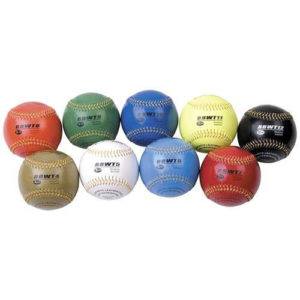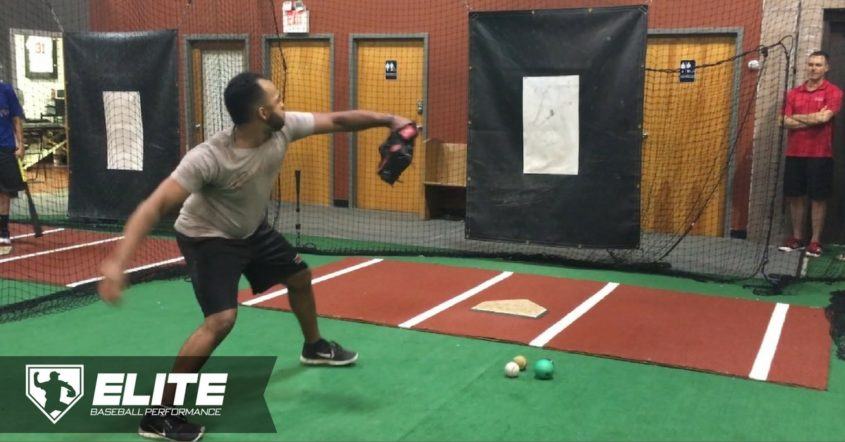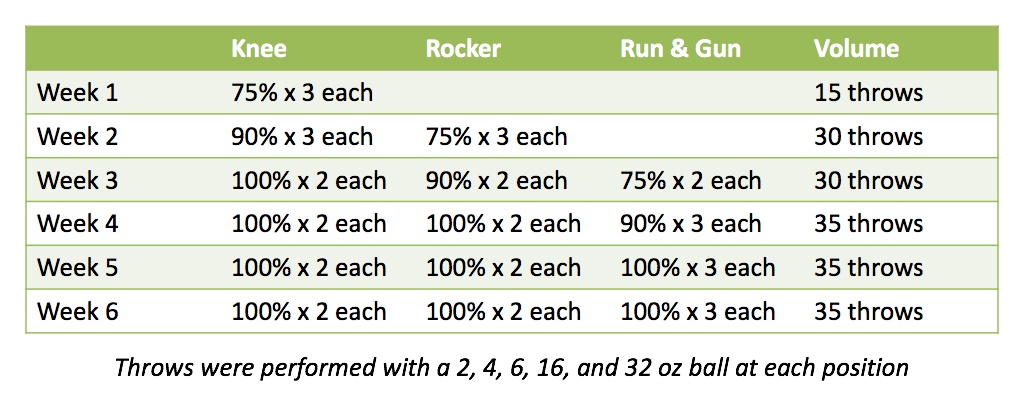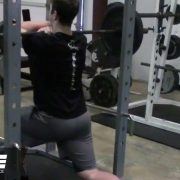Are Weighted Baseball Velocity Programs Safe and Effective?
Weighted baseball velocity training programs continue to rise in popularity in baseball pitchers of all levels despite us not knowing why they may improve velocity, the long term effects on the body, or the most appropriate program to perform.
Unfortunately, it seems like the trend is towards more aggressive programs every day.
The following is a summary of the 2-year research project that we have just finished conducting at Champion PT and Performance. Myself and Lenny Macrina teamed up with Dr. James Andrews and Dr. Glenn Fleisig of ASMI to design and conduct the first study to document the effects of a 6-week weighted baseball training program on pitching velocity, arm characteristics, and injury rates.
This may be the most important research project I have conducted to date. Weighted baseball programs continue to rise in popularity while injury rates continue to soar in baseball. This is completely unbiased scientific research that has been conducted with sound methodology. I actually make a living rehabbing baseball injuries, so you can assure I am sincere when I say I want to decrease the amount of baseball injuries.
I simply want to advance the game of baseball.
The injuries we are seeing at the youth, high school, and collegiate level are heartbreaking. Collegiate and minor league baseball pitchers are having their second Tommy John surgery, which have a low success rate. When I first started working with baseball players, Tommy John surgeries were occurring in older baseball veterans, not youth. The severity of injuries we are seeing are significant. Never before in my 20 year career have I seen such an enormous amount of significant injuries in baseball players.
We have presented the findings of this study at numerous conferences so far, and the manuscript is currently submitted for publication in a scientific journal. It is currently in the running for the 2018 Excellence in Research Award by the Sports Section of the APTA.
I’ve decided to publish an initial summary because I know many people are looking to start weighted baseball velocity programs this offseason. The journal submission and publication process can takes months or even years to finally get the information published, and I did not want to delay any further.
We Still Don’t Know the Science Behind Weighted Baseball Velocity Programs
There has been a recent increased emphasis on pitch velocity within the amateur and professional levels of baseball. According to Pitch/FX data, the average fastball velocity in MLB has gone up each year since tracking began in 2008, from 90.9 MPH to 93.2 MPH in 2017. Previous studies have shown both a correlation between increased pitch velocity and increased elbow stress and elbow injury rates. Thus, it is not surprising that injury rates continue to increase in a nearly linear fashion with increased average pitch velocity.
This emphasis on pitch velocity has resulted in the development of several velocity enhancement programs often marketed on the internet to baseball pitchers. These have become increasingly popular with amateur baseball players looking to enhance their playing potential in the future. One of the most popular forms of velocity enhancement programs utilize underweight and overweight weighted baseballs.
These programs have been theorized to enhance throwing mechanics, arm speed, and arm strength, resulting in enhanced pitch velocity, despite this not being validated scientifically.
Several studies have shown that weighted baseball training programs are effective at enhancing velocity, however, we still do not understand why or the long term effect of these programs.
Thus, the purpose of this study was to determine the effectiveness of a 6-week weighted baseball training program on enhancing pitch velocity while also quantifying the effects on biomechanical and physical characteristics of the shoulder and elbow.
How the Study Was Conducted
Youth baseball pitchers between the ages of 13 and 18 years old were recruited for the study. To be clear, there was one 13 year old who turned 14 shortly after, who was in the control group and did not throw weighted balls. The majority of subjects were ~16 years old. We just reported how old they were in year, not the months, many were almost 16 years old. If we were to have used the month, the mean would have been about 16 years old. We choose to use high school aged pitchers because we wanted the study to look specifically at this population, as these are the baseball pitchers that are often looking to perform a weighted baseball program due to the aggressive amount of marketing online.
38 youth baseball pitchers with the mean age of 15 years old met these criteria and agreed to participate. Subjects were randomly divided into a weighted baseball training group and a control group.
Upon enrollment in the study, baseline measurements of shoulder passive range of motion (PROM), elbow PROM, and shoulder strength were measured for each subject. They then underwent baseline pitching performance testing while we recorded pitch velocity, elbow varus torque, and shoulder internal rotation velocity using the Motus M Sleeve.
After the baseline testing, both groups were allowed to participate in a supervised baseball offseason strength and conditioning program. All subjects participated in a throwing program, but were not allowed to practice pitching off a mound.
The weighted baseball group performed a 6-week weighted ball throwing program in January and February of the baseball offseason. Throwing was performed 3 times per week. The 6-week program was developed to be similar, if not more conservative, than commonly marketed weighted baseball velocity programs available programs for baseball pitchers. The volume, frequency, and weight of the balls used was less than many popular programs.
Over the course of the 6-week program, throws were performed from the knee, rocker, and run and gun positions.
Athletes were instructed to throw at 75%, 90%, and 100% of their full intensity depending on the week of the training program. The intensity gradually ramped up over the course of the program. Throws were performed from each position on each training session with a 2 ounce, 4 ounce, 6 ounce, 16 ounce, and 32 ounce ball. One set with each weighted baseball was performed with the outlined repetitions below:
Many of commented about throwing 2lb balls at full intensity run-and-gun. Two things to realize about this:
- We choose to include this because this is being performed in our athletes
- Over the course of 6-weeks, there were 540 total throws, 18 of these were with 2lb balls at full intensity with run-and-guns. This only represents 3% of the program. We should not lose focus on the other 97%.
The control group performed an independent throwing program using standard regulation 5 oz baseballs and were not allowed to throw with any underload or overload balls.
All measurements were repeated after 6-weeks for both groups. The subjects went on to pitch as normal through spring and summer baseball season.
Below is a summary of the major findings of the study. The results were eye opening for me, personally. I feel like we have discovered why weighted baseball training programs may work, and you could argue this isn’t for a good reason.
Pitch Velocity Increased, But Not in Everyone
After 6-weeks, the weighted baseball group showed a 3% increase of 2.2 MPH, from 67 MPH to 69 MPH. The control group as a whole did not show a statistically significant increase in velocity. However, we did note that:
- 80% of the weighted baseball group improved velocity, and 12% showed a decrease in velocity
- 67% of the control group also improved velocity, and 14% showed a decrease in velocity
Weighted baseball training on average does help increase velocity, however, not in everyone and some people actually go down. Many people that did NOT perform the weighted ball program also increased velocity.
Shoulder External Rotation Increased, Likely in a Bad Way
There was a significant increase in almost 5 degrees of shoulder external rotation range of motion in the weighted ball group.
This rapid gain in external rotation occurred over a 6-week training program and did not occur in the control group. I have previously published my results and reported that shoulder external rotation increased from pitching, however, reported only a 5 degree increase in external rotation in MLB pitchers over the course of an entire 8-month baseball season.
While we are not able to determine the exact cause of the increased pitch velocity, based on past studies it may be from the increased amount of shoulder external rotation observed following the weighted ball training program. Previous biomechanical studies have shown that shoulder external rotation mobility correlates to both pitch velocity, as well as increased shoulder and elbow forces.
It is not known if such a rapid gain in external rotation following a 6-week weighted baseball training program is disadvantageous or challenges the static stabilizing structures of the shoulder. However, previous research has shown that 78% of pitching injuries occur in athletes with greater amounts of shoulder rotational motion.
Weighted Baseballs Do Not Increase Shoulder Strength, They May Actually Inhibit Strength Gains
One of the more interesting findings to me was that external rotation rotator cuff strength actually went up in the control group and not the weighted baseball group.
During the 6-week period, subjects in both groups were allowed to perform a baseball-specific offseason strength and conditioning program. Strengthening of the rotator cuff, particularly the external rotators, was a specific focus of this program and has been shown to increase pitching performance. The control group showed a 13% increase in dominant shoulder ER strength, which we were thrilled about, while the training group showed no change.
It appears that not only do weighted ball training programs not help develop rotator cuff strength, as previously theorized, they may in fact inhibit strength gains and should be further investigated.
Weighted Baseballs Do Not Increase Arm Speed or Strength
There were no statistically significant differences in valgus stress or angular velocity of the arm in either group.
Arm strength, arm angular velocity, and arm stress were not statistically different following the training program. This refutes the commonly reported theories that the effectiveness of weighted ball training programs can be attributed to the development of greater arm strength or arm speed.
24% of Pitchers Were Injured in the Weighted Ball Group
Potentially most important to the study was the finding that 24% of those in the training group either sustained an injury during the training program or in the following season, including two olecranon stress fractures, one partial ulnar collateral ligament injury, and one ulnar collateral ligament injury that surgical reconstruction was recommended. This is the first study to document the injury rates associated with a 6-week weighted baseball training program.
No injuries were noted in the same time span within the control group.
It should also be noted again that the weighted ball program utilized in the current study is far less aggressive in regard to the weight of the balls used as well as the volume and frequency of throwing, in comparison to many commonly performed programs.
Of note, two players of the players that were injured both exhibited the greatest amount of increase in shoulder ER PROM of 10 and 11 degrees, making this appear to be related.
It is unclear how quickly athletes gain external rotation and whether it occurs at a safe rate, and future research should attempt to answer this question. While pitch velocity may be enhanced, injury risk may also be elevated when performing a weighted baseball training program. Future studies should continue to assess the effects of different weighted ball training program on different age groups. We still need to find the right dosage to maximize the effectiveness while reducing the injury risk.
Should You Perform a Weighted Baseball Velocity Program?

It is still unknown why velocity goes up.
Since arm strength and speed were not changed after the training program, and Dr. Glenn Fleisig of ASMI has shown no change in mechanics, the increased pitch velocity observed may be related to this gain in shoulder external rotation motion.
This is alarming to me, as I feel this may also at least partially explain the increase in injury rates. This is not natural.
Who May Want to Perform a Weighted Baseball Program
Realistically throwing any baseball, even a standard 5 oz baseball, has an inherent amount of risk. I, in fact, actually including weighted balls at times in both our rehabilitation programs and our Elite Pitching Performance Program at Champion.
However, we do them in a very controlled fashion with less volume, intensity, and weight. We perform 4-7 oz throws with many of our athletes, however we have strict criteria to do so, that includes:
- Full skeletal maturity
- Efficient throwing mechanics
- Baseline of strength and conditioning (usually a year or more of training)
- Baseline of arm strength and dynamic stability (usually a year or more of training)
Essentially you need to be mature and developed enough to withstand the stress of these programs as well as justify the need to push the limits. Weighted baseball programs should not be where you begin when developing pitching performance. If you skip any of the above steps and jump straight to weighted baseballs, you are focusing on the frosting before you even baked the cake.
For you to use lighter balls, heavier balls, or aggressive run-and-gun drills, you need to be even more advanced. Few will meet this criteria.
There are many people that are willing to accept the increased injury risk, especially older baseball pitchers that are trying to make it to the next level. Weighted ball programs may be an effective option for you in this case, especially if you have maximized your throwing mechanics, strength and power development, and arm strength and dynamic stability.
Unfortunately, most baseball pitchers I meet have not done so.
Who Probably Should Not Perform Weighted Baseball Training
While some older baseball pitchers may be willing to accept this risk in an attempt to extend their career or take their game to the next level, it’s difficult to recommend most others perform an aggressive weighted baseball training program.
I’m not talking about warming up with a few light throws with a 6 oz ball, I’m talking about an aggressive several week- to month-long program with aggressive intensity using underload and overload balls. These are the videos that are being sensationalized on Instagram so much.
Because it appears weighted baseball training programs are likely effective by pushing your physiological limits, they should be reserved for those that have maximized their potential and have again achieved our criteria of:
- Full skeletal maturity
- Efficient throwing mechanics
- Baseline of strength and conditioning (usually a year or more of training)
- Baseline of arm strength and dynamic stability (usually a year or more of training)
Basically, if you are still growing, have inefficient mechanics, haven’t been training in a weight room for a significant amount of time, and have never performed an arm care program, you’re not prepared to perform a weighted ball program.
Plus, I can show you several scientific studies that show different training programs and arm care programs can be just as effective, if not more, at gaining pitching velocity without the inherent risk.
We can’t just be jumping to the quick fix.
The problem I am seeing is that we are using weighted ball programs with everyone, regardless of age, mechanics, training level, and injury history. This and the fact that we continue to try to push the limits and get more aggressive. If a 16 oz ball works, than a 32 oz ball may be twice as effective. This is simply unrealistic and unsafe to think this way.
More is not better.
I’ve talked about this before in my article, “Are Baseball Velocity Programs to Blame for the Rise in Pitching Injuries?” We are overdosing.
I think the most scary trend I am seeing in baseball right now is the blind use of generic weighted baseball programs. This includes people buying a random program on the internet, or worse, a baseball coach starting one generic program with all players on the team.
We’ve seen college teams with 4+ Tommy John surgeries with their players in one season, this was unheard of just a few short years ago.
We need to make the adjustment.
Weighted ball programs must be individualized, monitored, and implemented progressively. If you can’t do this, you shouldn’t be using them.
Not everyone is appropriate for weighted baseball programs. Many players that are currently performing a program probably shouldn’t be doing so, especially if they haven’t established a proper foundation of strength training, arm care, and physical maturity. In fact, at Champion, we have found that stopping weighted ball programs in those that are not ready for this stress has resulted in an even bigger gain in velocity after we have focused on foundational strength training and arm care programs.
Call to Action to Everyone in Baseball
I need your help.
We need to get this information out there so we stop seeing so many injuries in baseball pitchers. Baseball players, parents, coaches, and even rehabilitation and fitness specialists that work with baseball players need to understand the science behind weighted baseball training programs.
Yes, velocity goes up, but at what cost?
Based on this study, weighted baseball training does not change mechanics, increase arm speed, or increase arm strength. In fact, they may inhibit strength gains. They do stretch out your shoulder in a potentially disadvantageous way and lead to a 24% chance of injury. 1 in 4 players sustained an injury. Are you willing to accept that risk?
Once you understand the science, you can make a more educated decision if using weighted baseballs is appropriate for you. And if you do, how to safely and effectively choose to use these programs on the right players at the right times.
Please share this article with anyone that you feel shares our goal of advancing the game of baseball. I feel that many baseball players, parents, and coaches simply are not aware of the science. The more we can share the science, the better we can become.
We need to get better. We need to accept the science.
Mike Reinold
Latest posts by Mike Reinold (see all)
- 3 Ways Baseball Pitchers Can Use a Radar Gun to Enhance Performance - April 16, 2019
- 3 Things Baseball Players Need to Develop Elite Pitching Performance - January 15, 2018
- How to Get Your Arm Loose When Throwing Indoors - November 14, 2017












Mike thank you for sharing and being the trusted authority!
The main problem I have with this article is that the proposition is Weighted ball programs such as Driveline do not include high intent throwing with overload or under load balls. In fact, weighted balls are used very sparingly and used only prior to throwing 5 oz. balls. The weighted balls are supposed to be thrown at sub-max intent. I agree with Mike on the fact that throwing over/underload balls at a high intensity can be very dangerous. The problem I have is that the experiment you conducted with the players isn’t at all similar to the most popular program. I think it was a very good article with truth to it based off what the experiment you conducted was, but the experiment wasn’t at all similar to what weighted ball programs are like. It can be misleading to people who have not done the research or are not as involved in the baseball space.
Hey Joey, thanks for your reply. I agree, great comments.
At the time our study was conducted, that was in fact what common weighted ball programs looked like from most of the popular programs. These are the ones that the kids were doing, we put a lot of effort into making this realistic. I’m proud to see the baseball community taking the results from our studies and adjusting to make weighted balls safer.
That being said, if you look at our study, the majority of throws were done at partial effort, so I wouldn’t cast it off just yet. And remember, it’s all a physics equation that has to do with cumulative load. Meaning, just because you are throwing with less intent doesn’t make them “safer.” It just changes the load.
There is still a change in stress with weighted balls. What I’m worried about now is that the volume is too high, even at lower intensities. This will also change the workloads, but the majority of ligament injuries don’t happen on one pitch, they happen over time after exposure to too much load. It’s not just the weight of the ball, but also the intensity, volume, and frequency that we need to monitor.
Thanks again!
Hi Mike,
Did the Weighted ball group throw the 16 and 32oz at max intent and with the Run and Guns?
Thanks,
– Garrett
They did!
Mike thanks for this information. In your opinion, in the strength world are there certain % you would want to see some of these athletes being able to lift before performing a weighted program. You talk about having a strength background. I have seen studies stating wanting to have athletes be able to squat a certain % if their body weight, or split squat for examples. Could you see there being a correlation between this as a precursor to being able to do programs of this nature. Again thanks for all the information
Hi Logan, I wish it were that simple. Strength is just one small factor. I think we’ve learned even more about weighted balls over the years and I’m just not seeing enough reason to use them in youth, and maybe even more.
Thank you for the summary. I look forward to reading the full study. I have trained a handful of throwers in order to prevent surgery, and have also rehabbed throwers post surgery (both GH and UCL). I suspect that I will see more and more athletes due to the increasing use of weighted ball programs. Thank you so much for being an objective source of information.
Mike, I passed along this information to the entire baseball organization I belong to. If this knowledge saves even 1 player from being injured this coming season, it would be worth it. Thanks for your research.
Hey Mike,
I am a pitching instructor for 16+ years and I agree that injuries are way up. The fact that more kids are playing the sport would probably be a major factor, not to mention social media, parents and coaches constantly pushing for more “velo”. As a former pitcher myself, I can tell you that the heavy ball routine has been around for a long time and my college coaches put us through somewhat similar drills. I hated throwing with a heavy ball and only did it a few times. I would usually experience pain in my elbow and soon stopped and never went back to it. However, as much as I agree with you that heavy ball “throws” are not good for the arm, I do feel that there are benefits of a heavy ball program where you never throw the ball. These are “holds” and a few years ago I went through a similar program myself. I wanted to test it out before I put any of my pitchers through something some guy is selling off the internet. At the time I was in my late 30s and was throwing almost every day with my lessons to get them warm (5-8 lessons and 3-4 days a week) I got to the point where my entire arm was KILLING me and was looking for alternatives to allow me to not throw so much. I had been hearing a lot about this heavy ball program. Long story short, I did it for about 2 months where I went through a series of holds with unloaded and loaded balls. After a few weeks, the pain my arm was feeling had pretty much gone and I was throwing a 5oz baseball with ease and more life in my arm. After about 2 months of doing this routine, my arm started to feel like it did back in college. I tell you this to ask if it would it be possible for you to do the same study with a controlled group and the new group that does not throw the heavy balls? I would really like to see if there is a drill that could actually help and not hurt arms. Thanks for the original study. I feel more need to speak out because arm injuries are definitely a major concern these days.
This is a similar concept or motion that tennis players go through during their serve, yet, we don’t hear too much about them having shoulder or elbow injuries, similar to pitchers. Is that because of the fact that they’re not letting the racquet go, similar to the concept of weighted ‘hold’ throws? There must be some sort of correlation and I’d be interested to hear if anyone has feedback.
Tennis players have tons of shoulder and elbow injuries, we just don’t hear about them as much. They also have tons of biomechanical stress, even though they don’t let go of the racket.
Hi Kevin, do you think you obtained improvement in arm symptoms because you weren’t throwing as much and you let the arm have active rest with the holds? Just curious and wondered if we could exclusively attribute the betterment to just the holds? I do like your idea of adding your technique to current research to investigate further!
Hi Kevin, I would love more details about how you employed the “hold” in your program. Were you stopping your arm before the nature release point? Thanks!
Mike, thank you for all the work you do in furthering or knowledge and understanding regarding the affects that various training programs have on the arm. In this particular study did you do any on-ramping with them other than varying intensity of throws? Also, where did you get the example weighted-ball program? I know there already has been much debate regarding the use of 16oz and 32oz R&G, what was your reasoning for including this in your study if it is not readily being done at higher levels of competition? Great stuff and I look forward to reading the entire study.
Great info.
I am curious if this study and WB throwing program actually mimics the one out there (I think most in the baseball community know – I will not name the entity because it would be unfair to do so – they do great research themselves). Reason I say this too, is because their program does NOT throw 16 or 32 oz run and gun throws, walking wind ups, roll into throws, etc. with that heavy of implements. Use of heavier implements (at least my understanding) is more to strengthen and work on the deceleration phase and musculature than anything else. In fact, even the usage of 10 or 12 oz balls in their throwing program is minimal.
Something else to consider, is what type of arm care was coupled with this study? What was done in between on the “off days” or pre or post throwing? Were these subjects just throwing weighted balls at prescribed throws and then doing zero recovery afterwards? There are a lot more questions to raise outside of just saying that “player X” threw this many overload throws and this is the result. I think the reaearch is great, but I don’t know what else each player did besides throwing wieghted balls. Did one player do more arm care than another? Depending on the program being mimicked with this study, I think it is important to note that some type of analysis of the program, besides just the weighted ball throwing, has to be done top to bottom before a result can truly be conclusive as negative. 24% injury risk is pretty telling though and cause for pause.
Having an understanding of getting a full physical assessment and screening of each player for deficiencies, arm health history, body weight to body fat %, overall strength, etc. There are so many factors that come into play here before knowing if the weighted ball program contributed to an underlying problem not diagnosed first.
Do I agree that added external rotation probably leads to more risk of injury? Probably so, why would it not based on the studies out there. But there are so many other contributing factors that have to be looked at here.
I am a proponent that improving overall strength and doing routine diligent arm care can get velocity gains safer. But that added strength can also allow a player to participate in and test the limits of a supervised ballistic throwing program. I can see the benefit but realize it’s not for everyone. Participation is individual and cannot be cookie cutter-esque. You have to know your limits physically and also what your arm is telling you that day. Research any program thoroughly first and its use of weighted implements – ramping up and deloading have to make sense. Unfortunately, many players don’t take the time to understand the science and what the purpose is in implementing WB programs and whether players are suited physically and mentally to gain benefit from one. This is why many of us coaches read guys like you. The information is great. But what we all do with it is what’s really important.
You are spot on and I couldn’t have said it better.
Ryan makes a lot of great points. The program he’s talking about is in my opinion far more sensible that the one in the study presented.
The thing I took away from the study in the article is if 13-15 year old players were throwing 16 and 32 oz. balls with maximum effort I’m surprised all of them didn’t get injured.
I’m not disagreeing. One thing to clarify, however, was that there were 765 total throws over 6 weeks. 18 of these throws were with full intensity run-and-guns with a 2lb ball. This was 2% of the study. I don’t think it’s fair to say the other 98% of the study is harmless.
I understand the concern but as Ryan stated your study is severely flawed and requires much more variables to be included for it to be a “real” study of observation and results. As it is it’s simply conjecture based on limited measures and duration of training. Lastly, it’s crazy to even think about throwing a 2lb ball or over at 100%, 14 oz is pushing it and that is what a football weighs.
Mike–were players excluded if they didn’t meet total arc of motion guidelines or anything else?
Nope, just if they had an injury within the last 12 months.
Excellent information. I have several question. I was wondering how arm speed was assessed? Was arm velocity assessed ( instantaneous velocity)? Thinking back to the old physics formulas velocity and speed are two different measures. Did arm velocity increase with the weighted ball programs and if so could this be your cause of increased ball velocity? Could there be greater stored energy in the tendinous/ capsular interface in the training group as a result of the increased ER? This might explain the increased ball velocity . I think of the elastic components of the tendon/ capsular junction as a sling shot propelling the ball. Just some thoughts.
Hi Joe, arm speed was assessed using the Motus sleeve, it was angular velocity of the arm. All those could be true for sure!
Good information. The increase in ER may be from humeral torque that has been shown to occur in pitchers especially those who are skeletally immature (which would include 16 year old boys). It would appear to increase GH ROM, but actually is a rotation of the humerus itself and can definitely contribute to shoulder dysfunction in the future.
Hi Jake, I don’t think so, I don’t know if we would get that dramatic of a boney change in just 6 weeks, plus more importantly, the total rotational motion increased, meaning they gained ER and did not also lose IR, which would indicate the boney retroversion. Something happened to the passive restraints that are supposed to limit ER.
I’ve read a few good stuff here. Certainly price bookmarking for revisiting.
I surprise how much attempt you place to make any such excellent
informative site.